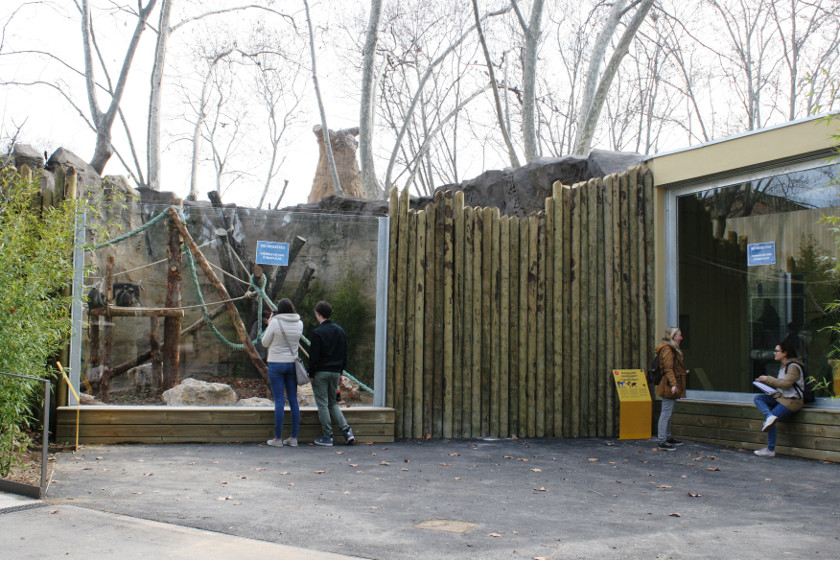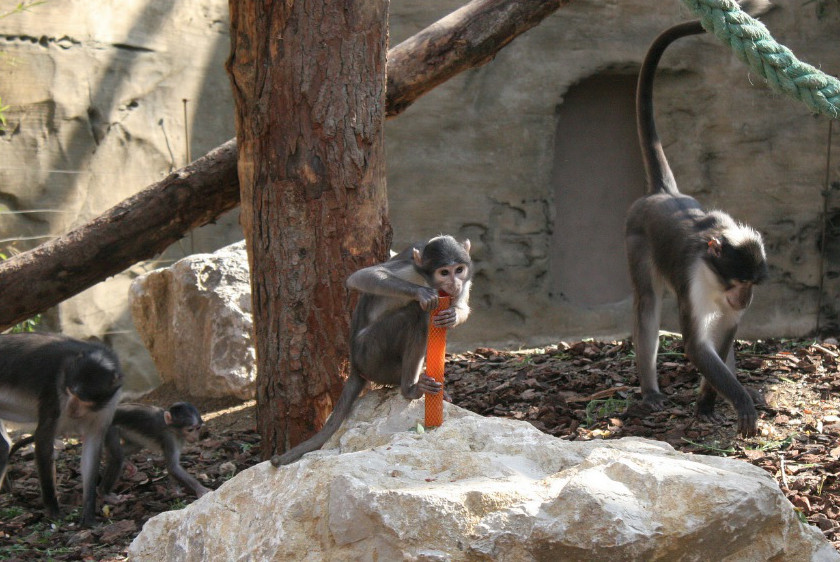The white-naped sooty mangabeys (Cercocebus Lunulatus) of the Zoo have a new facility! It is located next to the facility of orangutans and it is twice as large as the previous one. In this new 160 m2 area, the moat has been removed and the environment has been enriched with different structures, substrate and nets. Indoor areas have been extended up to 70m2, and they consist of 4 bedrooms with heating and a large lobby that can be seen by visitors, which enables to observe them even when there is bad weather and they decide to shelter from the cold. These facility makes management easier to integrate a new individual into the group.
These primates are named after their grey fur, which is darker on the back and whiter on the underpart. Of diurnal habits, they live in the rainforests of Ghana, Ivory Coast and Burkina Faso. This species is endangered and, due to poaching and the exploitation of its natural habitat, the distribution of its population is very fragmented and not abundant, in any of the areas where it still can be found. It was considered one of the 25 most endangered species of primates at the end of the 20th century and its wild population has been reduced by 50% during the last 30 years, due to deforestation for exotic wood market and fires to create crop areas, in addition to poaching, for the consumption of their meat.
The group of white-naped mangabeys in the Zoo of Barcelona consists of the male Racky, born in the Zoo of Accra in 2004 and transferred to Barcelona in 2014, who adapted very well to its new home, where he lives with two adult females, Kasi, born in Barcelona in 1997 and Monika, also born in Barcelona in 2009. Both gave birth a few months ago. In addition to these 3 adults, there is a young female, Kara, born in 2011, who had her first infant last year, and Phoebe and Nika, born in 2013 and 2014 respectively. The offspring born in 2016 are Ragnar, Eku and Priscilla.

Conservation programmes
The population of sooty Mangabeys is monitored in zoos of the European Association of Zoos and Aquaria (EAZA) since 1994. In 2001, a European Endangered Species Programme (EEP) was created for this species, which is coordinated from the Zoo of Barcelona, and is aimed to promote its ex situ breeding and to reduce the rate of inbreeding, which was quite high.
One of the pioneering initiatives within this program was to incorporate the Zoo of Accra (Ghana), located in the original geographic area of the species. This was possible thanks to the management and supervision of the Coordinator of WAPCA (West African Primates Conservation Action), a NGO made of some European zoos, including the Zoo of Barcelona, aimed to promote the in situ conservation of primate species in West Africa.

While initially the focus was set on the strengthening the population groups of Mangabeys in Accra, later this cooperation has also allowed for some specimens born in this city to be transferred to European zoos (such is the case of our male, Racky), thus improving the genetic variability of the ex situ population. The next goal of the program is to establish a group of mangabeys in the Zoo of Kumasi (Ghana), in a semi-liberty facility, to be able to observe their adaptation to a more natural territory. This is a pilot test that can help guide a possible reintroduction program of animals to natural parks, if the necessary conditions were met.
The Zoo of Barcelona provides technical and financial support to the conservation of this species in Ghana and every year funds the travel and stay in Accra of a researcher and some students of the University of Barcelona, under the direction of Dr. Montserrat Colell, who carry out several studies and tasks. This monitoring in the area is very important to help the Zoo of Accra improve its primate management techniques and enable a proper management of the mangabey populations.
The Zoo will continue to contribute to the conservation of white-naped Mangabe and raising awareness among visitors about the difficult situation of this and other species in the wild.



